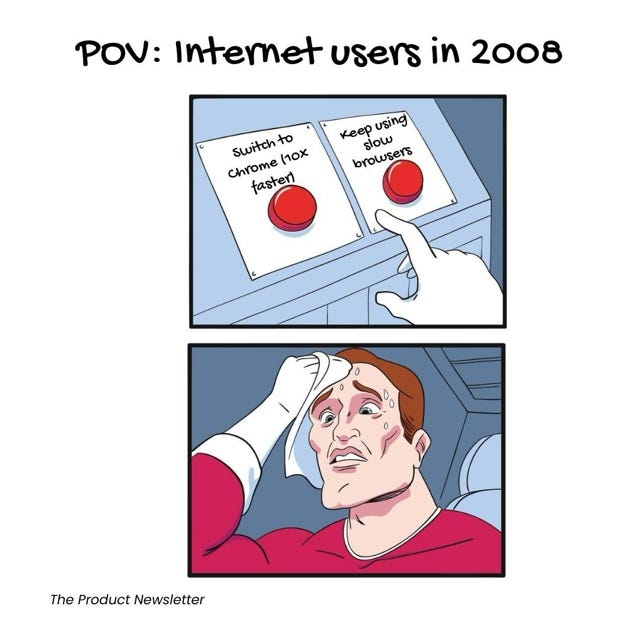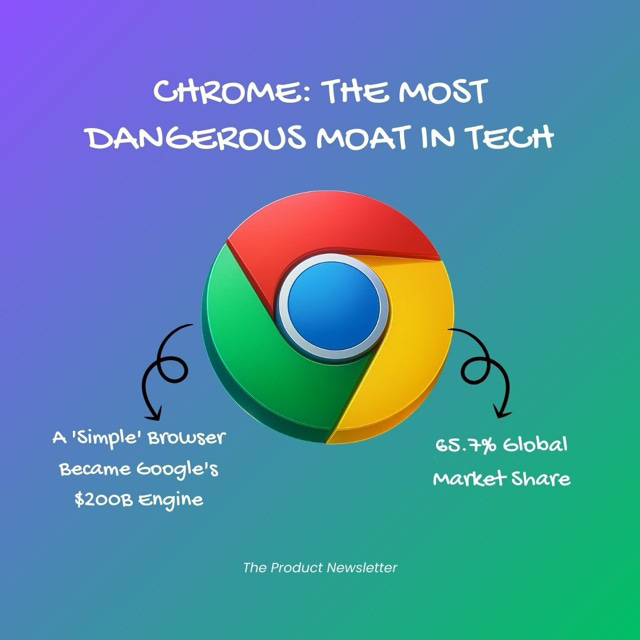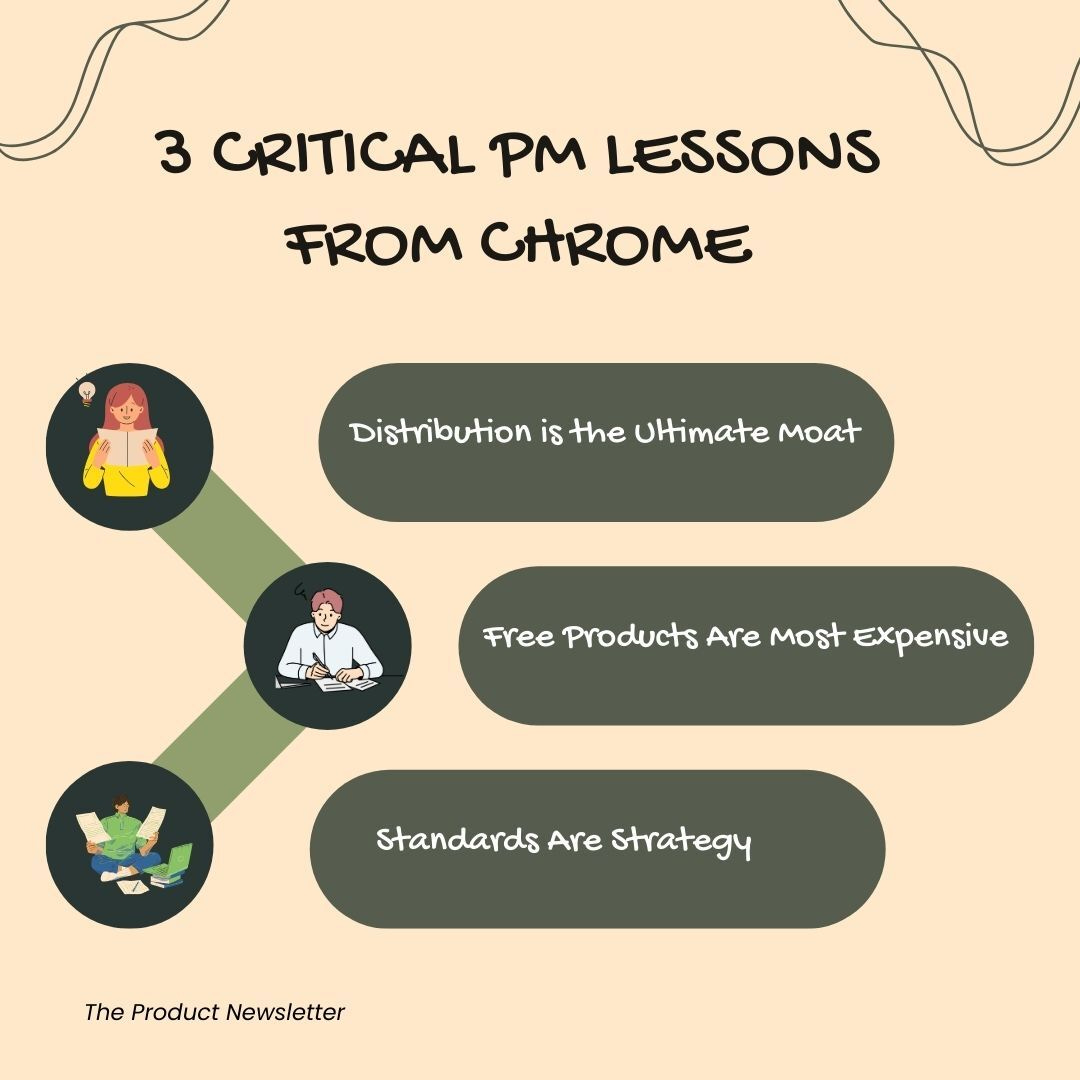Eval Drop #005: Chrome - The Most Dangerous Moat in Tech
This is how a "simple" browser became Google's $200B distribution engine and why every PM should study its playbook
Hi 👋! You are reading one of my free articles - I hope it helps you level up your PM skills. Want to go deeper? My premium subscribers get exclusive frameworks and strategies I don’t share anywhere else - content that has helped hundreds of product managers land better roles and make bigger impact.
Ready to accelerate your product career? Subscribe now for premium access and join a community of exceptional PMs gaining an edge every week.
Now, let’s dive into today’s insights…
Hi! You are reading another Eval Drop, where I break down products that shaped the internet and extract the PM lessons that matter.
This week is for Chrome. I call it the browser that ate the web.
From speaking with most people, the prevailing thought is that Chrome is just a browser. I think they are wrong. Chrome is Google’s Trojan horse, a distribution moat so powerful that regulators spend billions trying to crack it. It’s the product that ensures Google doesn’t just live on the web; Google is the web.
All that said, let’s dig deeper into how a late entrant to the browser wars became the most important piece of software infrastructure in the world.
1. What It Is
Chrome launched on September 2, 2008, six years after Firefox and fourteen years after Internet Explorer launched. Going by research, Google’s pitch was simple: a browser built for the modern web. Their unique proposition was for it to be fast, minimal, and secure.
Today, Chrome commands 65.7% global market share across 3+ billion users. It processes 8.5 billion searches daily. It’s the default development environment for 73% of web developers. And the interesting thing is this: it is free to use for all customers.
But Chrome is more than a browser. I like to describe it as an operating system for the internet, a data collection engine, and Google’s most powerful distribution channel rolled into one elegant package.
2. Who It Serves
Consumers → Fast browsing, seamless Google integration & cross-device sync.
Developers → Gold-standard DevTools, web standards leadership & extension ecosystem.
Enterprises → ChromeOS, fleet management & education dominance (60% of K-12 in the US).
Google → Search queries, ad targeting data, AI training ground & platform control.
The Google team has done an astounding job of making each audience persona believe Chrome exists primarily for them.
3. What It Gets Right
Speed as identity - Chrome’s V8 JavaScript engine was 10x faster than competitors in 2008. They turned performance into brand equity. Even today, when Edge runs on the same engine, people still perceive Chrome as faster.
The omnibox revolution - Combining URL and search into one bar seems obvious now but a few years ago, it wasn’t. This single UX decision drives 15% more searches than traditional layouts.
Silent ecosystem lock-in - Signing into Chrome will have you signed into your Google accounts simultaneously. Your passwords, bookmarks, history, and payment methods are all synced. The switching cost compounds daily. After 6 months, the average user has 47 saved passwords. Good luck leaving.
Developer king-making - Chrome DevTools didn’t just help developers, it made Chrome the browser where things got built first. When developers choose your platform, standards follow. When standards follow, you control the game.
The extension moat – Not sure you have noticed, but with 180,000+ extensions in the Chrome Web Store, it becomes difficult not to use Chrome daily, even worse, making it difficult and expensive for you to switch. Smart PMs know this; third-party developers are free R&D.
4. Where It Falls Short
The RAM monster – If you did not know, Chrome uses 3.7x more memory than Safari on average. While writing this, I discovered that the joke “Chrome eating RAM” has its own subreddit with a shocking 147K members. I think performance perception is shifting.
Privacy theater – According to Google, “privacy is fundamental.” Yet I, along with many others I’ve spoken with, still see targeted, often irrelevant ads everywhere. The cognitive dissonance is real. The earlier referenced Reddit subreddit I mentioned cited 42% of users have complained about privacy concerns, yet they keep using it. This may just be a ticking time bomb, especially as perplexity aims to buy Chrome.
Innovation plateau - When last did Chrome wow you? Tab groups (2020)? To an extent, the magic feels gone. Meanwhile, new entrants like Arc are redesigning browsing from scratch, and Brave is building a privacy-first browser.
Mobile handcuffs - iOS users can set Chrome as the default, but Safari’s WebKit runs underneath. On iPhone, Chrome is essentially a Safari skin with Google sync. That’s 27% of the US market that Google can’t fully capture.
5. What They Are Optimizing For (My Opinion)
Looking at recent releases and insider moves, Chrome’s OKRs likely center on:
Logged-in users % (currently ~60%, target probably 80%).
Search queries per user (the real money metric).
Time to first AI interaction (Gemini integration everywhere).
Enterprise seat growth (ChromeOS in education + corporate).
Developer mindshare retention (fighting back against Arc, Warp).
However, let me shock you: Every “privacy feature” still requires a Google account.
6. What I would Do Differently
True “Private” mode - Not incognito theater. A genuine “Google-blind” mode. No tracking, no sync, no data. Yes, it may temporarily hurt revenue, but it would also destroy the competition’s main attack vector.
Workspace browsing - Turn tab groups into persistent, intelligent workspaces. “Research mode” that auto-organizes sources. “Shopping mode” that tracks prices. "Focus mode" that blocks distractions. Make the browser adapt to intent.
AI-native architecture – I do not think Google should club Gemini with Chrome. They need to rebuild browsing around AI. Imagine Chrome understanding page content, suggesting next actions, and auto-completing complex tasks. Not an assistant but an intelligence (orchestration) layer.
Radical transparency dashboard – Users should easily access and know what data Chrome collects and why. Make privacy settings visual, not buried in menus. Trust should be attained through transparency.
Developer renaissance - Launch a $100M fund for Chrome-first innovations. Make building for Chrome as lucrative as building for iOS. Own the next generation of web capabilities.
7. Where It Fits Strategically
Chrome is Google’s control panel for the internet:
Search distribution: 92% of Chrome users use Google Search.
Ad ecosystem: First-party data from 3 billion users.
Web standards: Chromium powers Edge, Brave, Opera, Vivaldi.
AI deployment: Testing ground for Gemini integration.
Enterprise foothold: ChromeOS in education creates lifetime users.
8. The PM Takeaway
Chrome is a masterclass in three critical product principles:
Distribution is the ultimate moat - Chrome proves that controlling distribution beats having the best product. Google Search stays dominant not because it’s 10x better, but because Chrome makes it 10x easier to use.
Free products are the most expensive - Chrome costs Google $3-4B annually to develop. But it drives $150B+ in search revenue. The best business model? Give away the storefront, own the mall.
Standards are strategy - By open-sourcing Chromium, Google got competitors to build on their platform. Microsoft Edge runs on Chromium. That’s not competition but more controlled opposition.
The interesting fact is that Chrome won by being great, then stayed winning by being the default. Every PM should study this playbook and understand why regulators want to break it apart.
If Chrome is Google’s moat, what happens when AI makes browsers irrelevant? This is the $2 trillion question no one is answering. At least, not yet.
P.S. – If you missed the last eval, I broke down YouTube’s creator economy engine. Read it here.
ICYMI: If you’ve been following my newsletter lately, you’ve probably noticed that product evals have become one of my main moats. I believe that breaking down the behind-the-scenes frameworks behind today’s top product market leaders is the cheat code every PM needs. On that note, here are some past issues to get you up to speed 👇🏾
This article answers the question on every product person’s mind: “How does YouTube manage to stay relevant for over a decade, and what goes on behind the scenes?” Click the link below to find out the answer 👇🏾
In this piece, I took apart everyone’s digital résumé, LinkedIn, and broke down what works, what doesn’t, and what could be better. Read it here 👇🏾






